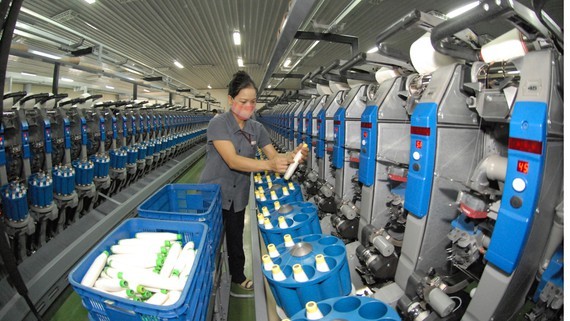Though Vietnam is the third largest exporter of textiles and clothing in the world, second only to China and India, the country’s textile industry is highly dependent on China's raw materials. Due to the sudden public health incident, some factories in China have postponed production, so the supply chain of Vietnam's textile and garment industry is seriously affected.

In the middle of March, Song Hong Garment and Textile Company kicked off construction of its factory in Nghia Phong Commune in the Northern Province of Nam Dinh with 40 sewing and weaving production lines in the area of nearly 75,000 square meter with investment totaling VND600 billion (US$ 26,034,523). The factory scheduled to come into operation in November is expected to help increase the company’s revenue to VND5 .5 trillion.
Beforehand, VND180 billion Trung Quy weaving and dyeing facility with annual production capacity of about 2 million meters of all kinds of fabrics had been operated in Hai Son Industrial Park in the Mekong Delta Province of Long An before Tet holiday ( the Lunar New Year).
Simultaneously, Nghe Tinh Textile Company was greenlighted to operate a OE yarn manufacturing facility to meet demand of the textile industry producing 18,720 tons of thread yarn per year. The VND600 billion plant was built in Nam Hong Industrial Park in the Central Province of Ha Tinh’s Hong Linh Town.
Leaders of these above-mentioned enterprises said that they will help ease their own shortage of materials as well as provide materials for other companies. Moreover, these facilities have come into operation at the time when free trade agreements (FTAs) and the EU-Vietnam Free Trade Agreement (EVFTA ) came into effect; therefore, Vietnam is eligible for preferential export and import tariffs for complying with EVFTA’s rule of origin.
In addition to locally-invested factories, Foreign Direct Investment-invested fabric projects have been completed and come into operation, including Hong Kong Texhong Textile knitting plant in Texhong Hai Ha Industrial Park in the Northern Province of Quang Ninh with the total investment of US$214 million.
According to the Vietnam Textile and Apparel Association (Vitas), Vietnam is the third largest exporter of textiles and clothing in the world, it is still heavily dependent on imported materials. Specifically, in 2020, the textile and garment sector achieved revenue of U$35 billion; yet, it spent nearly $20 billion on imported materials including $12 billion on fabrics. Therefore, newly-built factories both help Vietnam to enjoy FTA’s preferential tariff and create more employment for local laborers.
Vitas Chairman Vu Duc Giang said that the industry is facing big environmental challenges required by importers. When it comes to the industry’s revenue this year, Chairman Giang said that Vietnam can achieve around $37 billion - $38 billion as the development of the coronavirus pandemic has still been complicated in the world.
Mentioning material production, the leader of Vitas said that these newly-built factories have been reducing the shortage of material; however, he noted that enterprises should well study rules and road map for tariff cuts on many goods to most take advantage of FTA.
For long-term strategy, Vitas petitioned the Government to approve the industry development strategic plan by 2030 with the vision to 2035 for assisting enterprises. Additionally, the government should establish big textile industrial zones with centralized wastewater treatment plants to lure investment in weaving and dyeing to meet the sectors’ demand, said Chairman Giang.
























